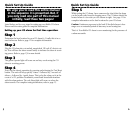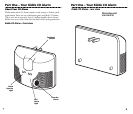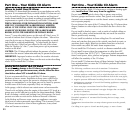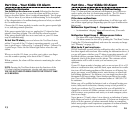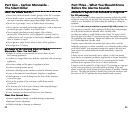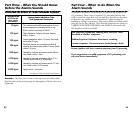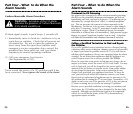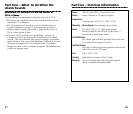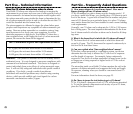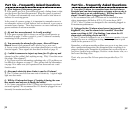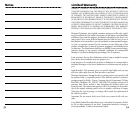
2221
Part Three – What You Should Know
Before the Alarms Sounds
Determine if anyone in the household is at high risk
for CO poisoning:
Many cases of reported carbon monoxide poisoning indicate that while
victims are aware they are not well, they become so disoriented they are
unable to save themselves by either exiting the building or calling for
assistance.
You should take extra precautions to protect high risk persons from
CO exposure because they may experience ill effects from carbon monox-
ide at levels that would not ordinarily affect a healthy adult.
Are there any infants or small children in the home? Be sure to check
them for signs of possible CO poisoning because they might have trou-
ble explaining their symptoms. Infants and children are more susceptible
to CO poisoning than a healthy adult.
Pregnant women should be aware that their unborn fetus could be
harmed by exposure to carbon monoxide, even when the mother suffers
no ill effect herself. Any pregnant woman who suspects she may have
been exposed to carbon monoxide should immediately contact her
physician.
Is there anyone in the household who is elderly, or who has anemia,
heart disease or respiratory problems, emphysema or chronic bronchitis?
These individuals are at higher risk for CO poisoning and for health
problems from exposure to low levels of carbon monoxide.
If anyone in the household is at high risk for CO poisoning, we urge you
to take extra precautions to prevent possible poisoning. If the unit
alarms, remove the at-risk person from the premises, if possible. Ventilate
the area. The high-risk person(s) should not re-enter the residence until
the source of the CO problem has been identified and corrected.
Part Two – Carbon Monoxide -
The Silent Killer
What You Should Not Do...
•Never burn charcoal inside a home, garage, cabin, RV or camper.
•Never install, service, or convert fuel-burning appliances from
one type to another without proper knowledge, skills, and tools.
•Never use a gas range, oven, or clothes dryer for heating.
•Never operate unvented gas-burning appliances, such as kerosene
or natural gas space heaters, in a closed room.
•Never operate gasoline-powered engines (like vehicles,
motorcycles, lawn mowers, yard equipment or power tools) in
confined areas such as garages or basements, even if an outside
door or window is open.
•Never ignore a safety device when it shuts off an appliance.
•Never ignore a CO alarm.
Be Aware of the Warning Signs of Carbon
Monoxide: Clues You Can See...
•Streaks of carbon or soot around the service door of your
fuel-burning appliances.
•A yellow or orange flame may indicate a problem with natural gas
appliances.
•Excessive rusting on flue pipes or appliance jackets.
•Loose or missing furnace panel.
•Moisture collecting on the windows and walls of furnace rooms.
•Loose or disconnected vent/chimney, fireplace or appliance.
•Small amounts of water leaking from the base of the chimney,
vent or flue pipe.
•Rust on the portion of the vent pipe visible from outside
your home.
•The absence of a draft in your chimney (indicating blockage).
•Fallen soot from the fireplace chimney.
•Loose, damaged or discolored bricks on your chimney.
Clues You Cannot See...
•Internal appliance damage or malfunctioning components.
•Improper burner adjustment.
•Hidden blockage or damage in chimneys.



